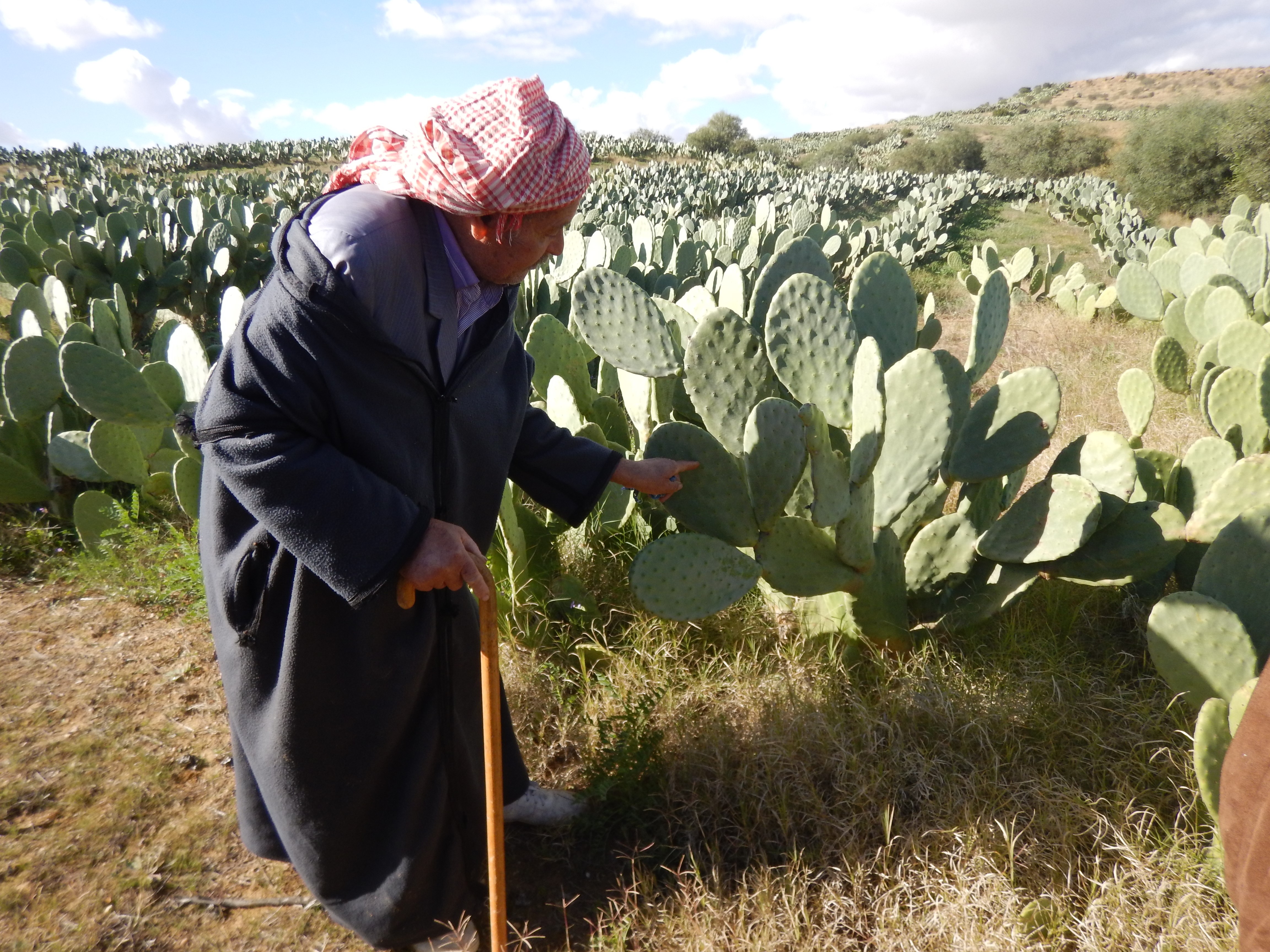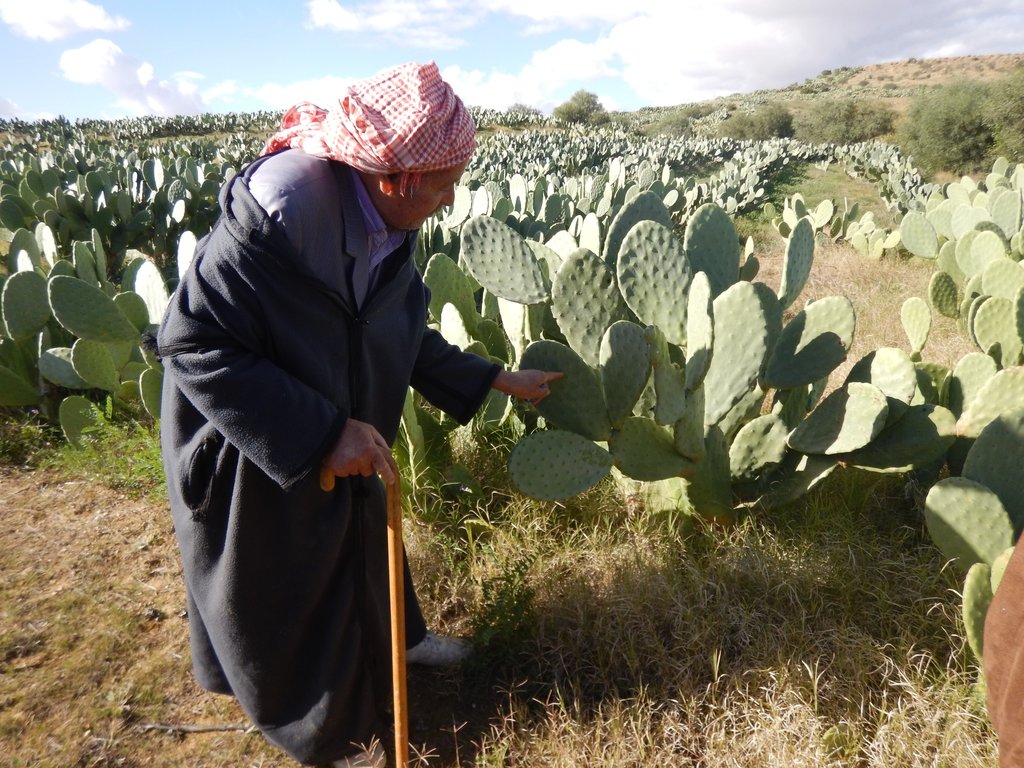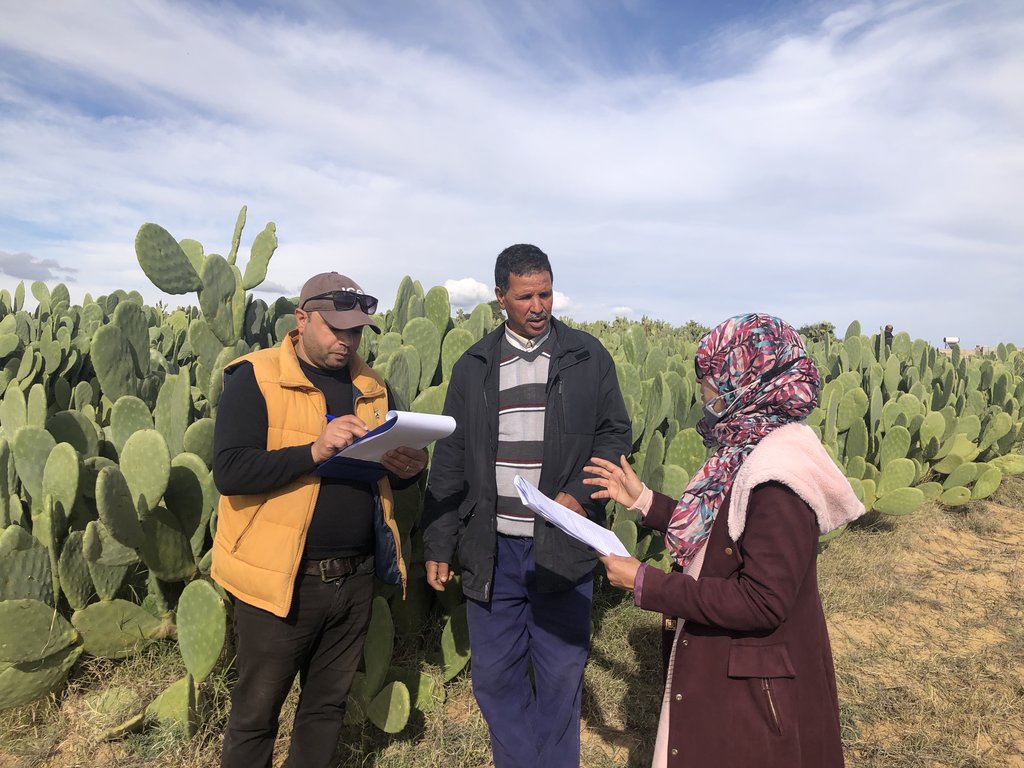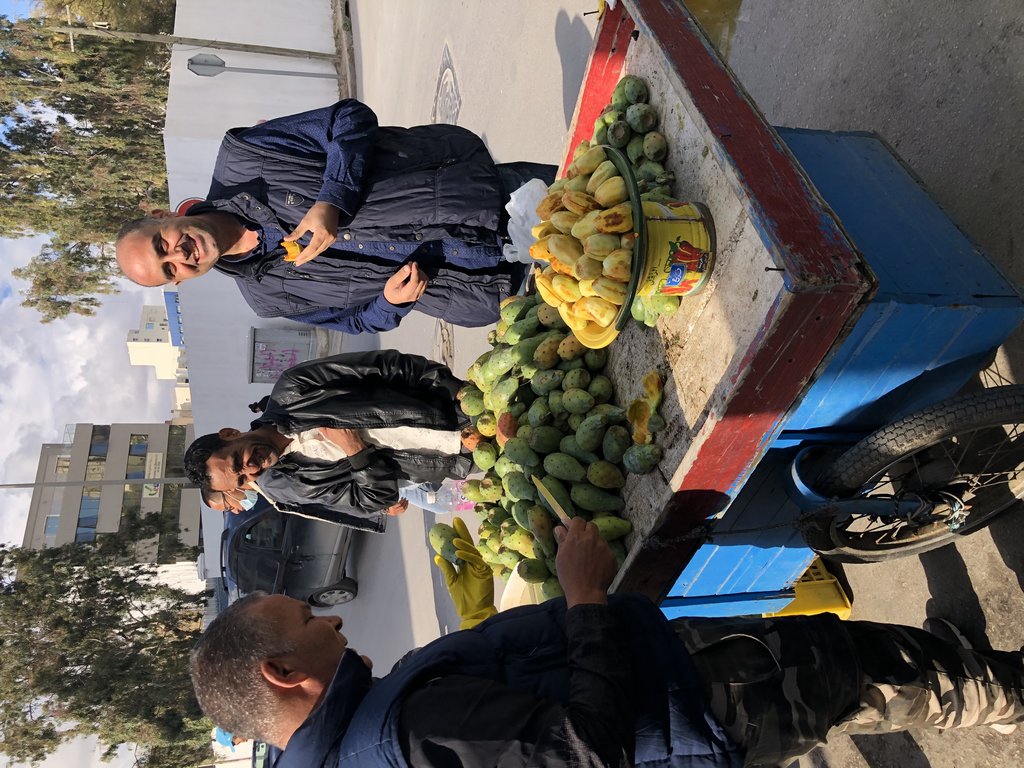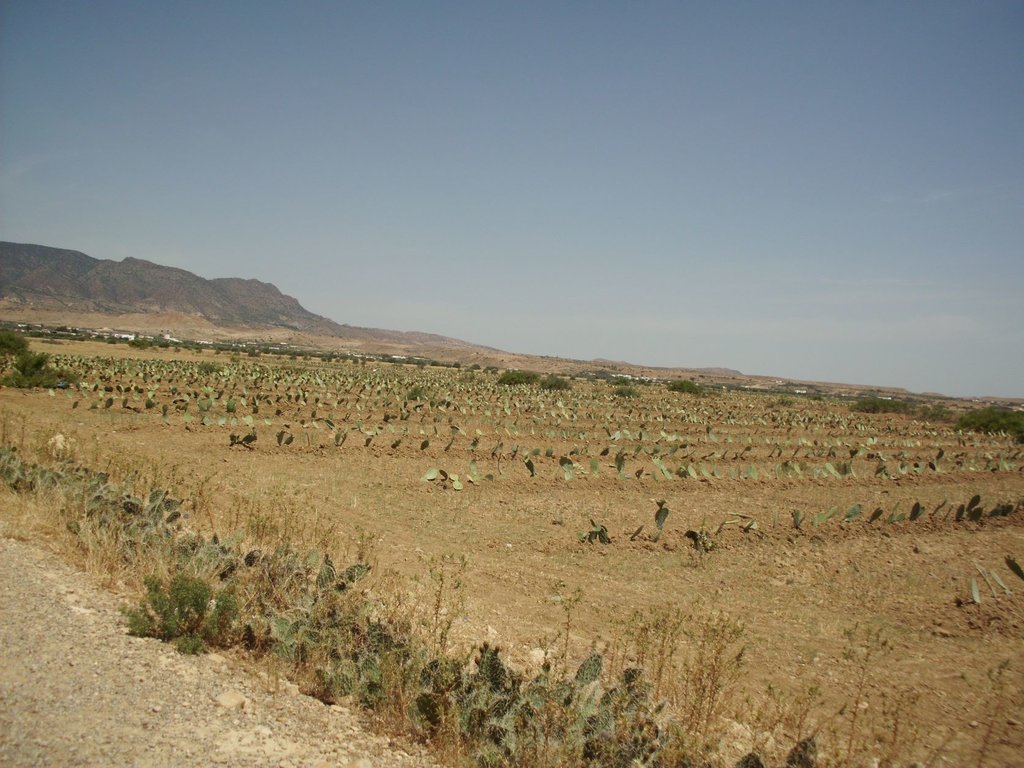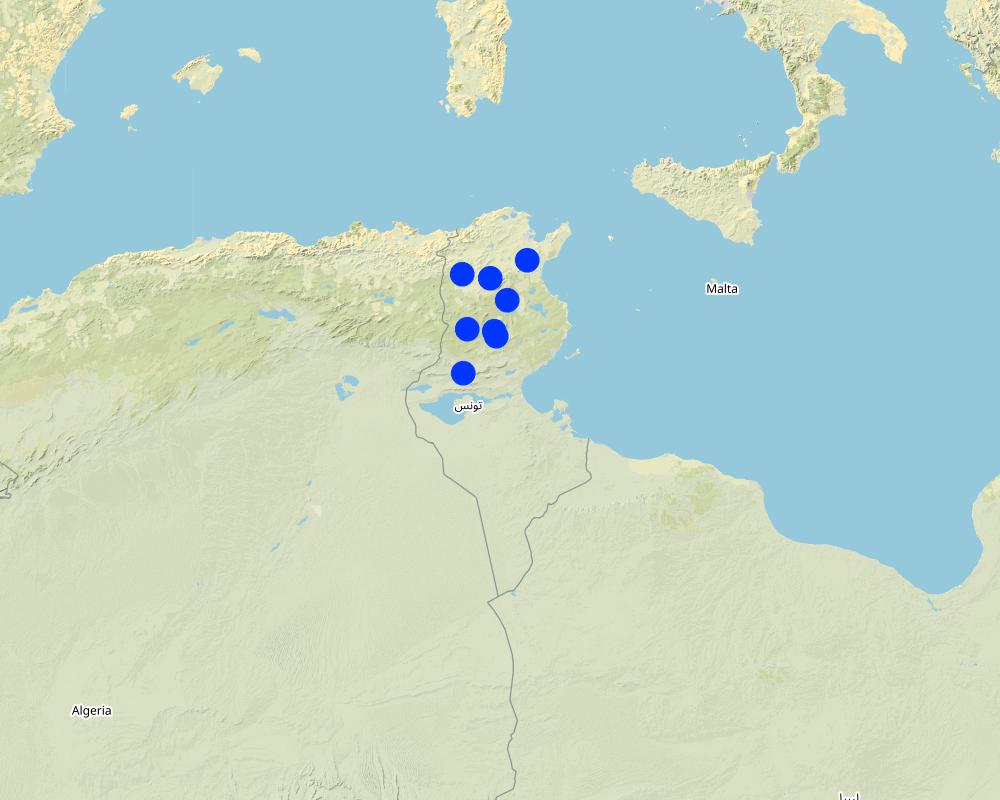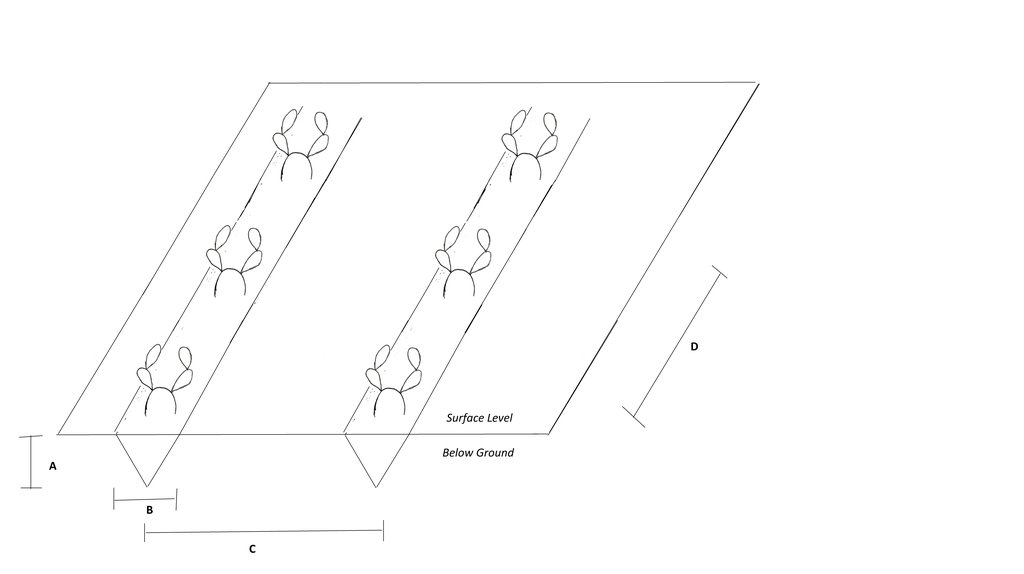Cactus Cultivation [ตูนิเซีย]
- ผู้สร้างสรรค์:
- การอัพเดท:
- ผู้รวบรวม: Joren Verbist
- ผู้เรียบเรียง: –
- ผู้ตรวจสอบ: William Critchley, Rima Mekdaschi Studer
technologies_5994 - ตูนิเซีย
ดูส่วนย่อย
ขยายทั้งหมด ย่อทั้งหมด1. ข้อมูลทั่วไป
1.2 รายละเอียดที่ติดต่อได้ของผู้รวบรวมและองค์กรที่เกี่ยวข้องในการประเมินและการจัดเตรียมทำเอกสารของเทคโนโลยี
วิทยากรหลัก
Research Team Leader of Rangeland Ecology and Forages:
Louhaichi Mounir
International Center of Agriculture Research in the Dry Areas (ICARDA)
ตูนิเซีย
Associate Professor:
Slim Slim
School of Higher Education in Agriculture of Mateur
ตูนิเซีย
ชื่อของโครงการซึ่งอำนวยความสะดวกในการทำเอกสารหรือการประเมินเทคโนโลยี (ถ้าเกี่ยวข้อง)
ICARDA Institutional Knowledge Management Initiativeชื่อขององค์กรซึ่งอำนวยความสะดวกในการทำเอกสารหรือการประเมินเทคโนโลยี (ถ้าเกี่ยวข้อง)
International Center for Agricultural Research in the Dry Areas (ICARDA) - เลบานอน1.3 เงื่อนไขการใช้ข้อมูลที่ได้บันทึกผ่านทาง WOCAT
ผู้รวบรวมและวิทยากรหลักยอมรับเงื่อนไขเกี่ยวกับการใช้ข้อมูลที่ถูกบันทึกผ่านทาง WOCAT:
ใช่
1.4 การเปิดเผยเรื่องความยั่งยืนของเทคโนโลยีที่ได้อธิบายไว้
เทคโนโลยีที่ได้อธิบายไว้นี้เป็นปัญหาของความเสื่อมโทรมโทรมของที่ดินหรือไม่ จึงไม่ได้รับการยอมรับว่าเป็นเทคโนโลยีเพื่อการจัดการที่ดินอย่างยั่งยืน:
ไม่ใช่
แสดงความคิดเห็น:
While Opuntia can be an invasive in North Africa, assurances have been given by ICARDA that this is a non-invasive species.
2. การอธิบายลักษณะของเทคโนโลยี SLM
2.1 การอธิบายแบบสั้น ๆ ของเทคโนโลยี
คำจำกัดความของเทคโนโลยี:
This technology is based on the natural advantages and the multi-purpose usage of spineless cactus pear (Opuntia fiscus-indica), to cultivate marginal lands in central Tunisia, generating environmental and socio-economic benefits.
2.2 การอธิบายแบบละเอียดของเทคโนโลยี
คำอธิบาย:
The central areas of Tunisia are semi-arid and receive less than 500 millimeters of annual rainfall . Most of these lands are considered marginal as result of land degradation. Marginal lands are often used as (unproductive) grazing land for livestock. To revitalize these areas and to benefit the local population, the International Centre of Agricultural Research in Dry Areas (ICARDA) and its national partners have investigated the potential of cactus as a crop (e.g. Opuntia fiscus-indica).
Spineless cactus was already introduced in Tunisia during the sixteenth and seventeenth centuries, but beginning in 1920-1930 cultivation for fodder production has gradually evolved. Opuntia is known for its invasive character, but the particular species being promoted - Opuntia fiscus-indica - is non-invasive. The crop is well suited for the Tunisian context because the cacti can cope with high temperatures and grow well in (semi)-arid areas with limited rainfall. Additionally, the plant is very resilient as it can withstand a long dry season due to its high water- content and water-use -efficiency, which are a result of its morphology (waxy cuticle, no actual leaves) and its Crassulacean Acid Metabolism (CAM). In a CAM plant, stomata in the leaves remain shut during the day to reduce evapotranspiration, but open at night to collect and fix carbon dioxide (CO2). In general, cacti have multiple products that benefit local livelihoods. These are, for example, stable production of fodder for livestock and fruits for human consumption. Also, cactus can grow and produce requiring few inputs such as fertilizers, therefore marginal lands are well suited for cultivation. The main current risk for cactus cultivation is the risk of cochineal, an insect pest.
To establish a cactus plantation, the surface is ploughed to loosen up the often crusted soil. Then furrows are constructed in which the cacti pads are planted. Simultaneously, the furrows are partly filled with manure. The depth and widths of the furrows are 30 centimetres. The spacing between plants within the row is 50 centimeters and the distance between rows is 5 meters.
A cactus plantation needs weeding. Weeding is mechanically done by a plough in March to May. Harvesting of fruit is manually done by fruit-pickers in August to September. Cacti can also be harvested for their pads, which can be fed to livestock or used for outplanting. It is excellent fodder as it has a high nutritional value and high water-content. On average, a farmer following these agronomic practices generates an income of 800 USD per hectare.
To conclude, this documentation shows that the implementation of cacti is socio-economically and environmentally appropriate to cultivate marginal lands as cacti uses water and nutrients highly efficient while reducing land degradation. Therefore, the out-scaling of cacti is very valuable and a practical option to fight land degradation and enhance smallholder’s income.
2.3 รูปภาพของเทคโนโลยี
2.5 ประเทศภูมิภาค หรือสถานที่ตั้งที่เทคโนโลยีได้นำไปใช้และได้รับการครอบคลุมโดยการประเมินนี้
ประเทศ:
ตูนิเซีย
ภูมิภาค/รัฐ/จังหวัด:
Central Tunisia
ข้อมูลจำเพาะเพิ่มเติมของสถานที่ตั้ง :
Kairouan, Zaghouan, Siliana, Kef, Sidi Bouzid, Kasserine and Gafsa
ระบุการกระจายตัวของเทคโนโลยี:
- กระจายไปอย่างสม่ำเสมอในพื้นที่
If precise area is not known, indicate approximate area covered:
- 1-10 ตร.กม.
Is/are the technology site(s) located in a permanently protected area?
ไม่ใช่
แสดงความคิดเห็น:
This documentation is a example of how cacti are cultivated in Tunisia, which is done on many (>100) farms.
The pin-points represent the provinces in which cactus are cultivated
Map
×2.6 วันที่การดำเนินการ
ถ้าไม่รู้ปีที่แน่นอน ให้ระบุวันที่โดยประมาณ:
- 10-50 ปี
2.7 คำแนะนำของเทคโนโลยี
ให้ระบุว่าเทคโนโลยีถูกแนะนำเข้ามาอย่างไร:
- ในช่วงการทดลองหรือการทำวิจัย
- ทางโครงการหรือจากภายนอก
3. การจัดประเภทของเทคโนโลยี SLM
3.1 วัตถุประสงค์หลักของเทคโนโลยี
- ปรับปรุงการผลิตให้ดีขึ้น
- ลดความเสี่ยงของภัยพิบัติ
- ปรับตัวเข้ากับการเปลี่ยนแปลงภูมิอากาศของโลก สภาพภูมิอากาศที่รุนแรงและผลกระทบ
- สร้างผลกระทบทางด้านเศรษฐกิจที่เป็นประโยชน์
- สร้างผลกระทบทางด้านสังคมที่เป็นประโยชน์
3.2 ประเภทของการใช้ที่ดินในปัจจุบันที่ได้นำเทคโนโลยีไปใช้
Land use mixed within the same land unit:
ไม่ใช่

พื้นที่ปลูกพืช
- การปลูกไม้ยืนต้น ไม้พุ่ม
Tree and shrub cropping - Specify crops:
- cactus, cactus-like (e.g. opuntia)
จำนวนของฤดูเพาะปลูกต่อปี:
- 1
Is intercropping practiced?
ไม่ใช่
Is crop rotation practiced?
ไม่ใช่

ทุ่งหญ้าเลี้ยงสัตว์
ทุ่งหญ้าเลี้ยงสัตว์ที่มีการจัดการแบบเข้มข้นหรือการผลิตอาหารสัตว์:
- ตัดแล้วขนไป / ไม่มีการปล่อยแทะเล็มเอง (Cut-and-carry / zero grazing)
Animal type:
- goats
- sheep
3.3 Has land use changed due to the implementation of the Technology?
Has land use changed due to the implementation of the Technology?
- Yes (Please fill out the questions below with regard to the land use before implementation of the Technology)

ทุ่งหญ้าเลี้ยงสัตว์
Extensive grazing:
- กึ่งโนแมนดิซึ่มหรือแพสโตแรลลิซึ่ม (Semi-nomadism/pastoralism)
แสดงความคิดเห็น:
Before cactus cultivation, the land was marginal and only lightly used by pastoralists due to the very poor production.
3.4 การใช้น้ำ
การใช้น้ำของที่ดินที่มีการใช้เทคโนโลยีอยู่:
- จากน้ำฝน
3.5 กลุ่ม SLM ที่ตรงกับเทคโนโลยีนี้
- การปรับปรุงดิน / พืชคลุมดิน
- การปรับปรุงพันธุ์พืชหรือพันธุ์สัตว์ต่าง ๆ
3.6 มาตรการ SLM ที่ประกอบกันเป็นเทคโนโลยี

มาตรการจัดการพืช
- A1: พืช/สิ่งปกคลุมดิน
- A3: การรักษาหน้าดิน

มาตรการอนุรักษ์ด้วยการจัดการ
- M1: การเปลี่ยนรูปแบบของการใช้ประโยชน์ที่ดิน
3.7 รูปแบบหลักของการเสื่อมโทรมของที่ดินที่ได้รับการแก้ไขโดยเทคโนโลยี

การกัดกร่อนของดินโดยน้ำ
- Wt (Loss of topsoil): การสูญเสียดินชั้นบนหรือการกัดกร่อนที่ผิวดิน
- Wg (Gully erosion): การกัดกร่อนแบบร่องธารหรือการทำให้เกิดร่องน้ำเซาะ

การกัดกร่อนของดินโดยลม
- Et (Loss of topsoil): การสูญเสียดินชั้นบน

การเสื่อมโทรมของดินทางด้านกายภาพ
- Pk (Slaking and crusting): การอุดตันของช่องว่างในดินหรือรูพรุน

การเสื่อมโทรมของดินทางด้านชีวภาพ
- Bc (Reduction of vegetation cover): การลดลงของจำนวนพืชที่ปกคลุมดิน
3.8 การป้องกัน การลดลง หรือการฟื้นฟูความเสื่อมโทรมของที่ดิน
ระบุเป้าหมายของเทคโนโลยีกับความเสื่อมโทรมของที่ดิน:
- ป้องกันความเสื่อมโทรมของที่ดิน
- ลดความเสื่อมโทรมของดิน
4. ข้อมูลจำเพาะด้านเทคนิค กิจกรรมการนำไปปฏิบัติใช้ ปัจจัยนำเข้า และค่าใช้จ่าย
4.1 แบบแปลนทางเทคนิคของเทคโนโลยี
ข้อมูลจำเพาะด้านเทคนิค (แบบแปลนทางเทคนิคของเทคโนโลยี):
A = Depth Furrow = 30 centimeter
B = Width Furrow = 30 centimeter
C = Spacing between rows = 5 meter
D = Spacing between plants = 0.5 meter
ผู้เขียน:
Joren Verbist
วันที่:
27/11/2021
4.2 ข้อมูลทั่วไปเกี่ยวกับการคำนวณปัจจัยนำเข้าและค่าใช้จ่าย
ให้ระบุว่าค่าใช้จ่ายและปัจจัยนำเข้าได้รับการคำนวณอย่างไร:
- ต่อพื้นที่ที่ใช้เทคโนโลยี
ระบุขนาดและหน่วยพื้นที่:
1 Hectare
ระบุสกุลเงินที่ใช้คำนวณค่าใช้จ่าย:
- USD
4.3 กิจกรรมเพื่อการจัดตั้ง
| กิจกรรม | Timing (season) | |
|---|---|---|
| 1. | Surface Soil Ploughing | Prior to Furrow Digging |
| 2. | Digging Furrows | Prior to Planting |
| 3. | Planting the Cacti | Spring to Autumn (During Planting) |
| 4. | Fertilizer Application | Spring to Autumn (During Planting) |
4.4 ค่าใช้จ่ายของปัจจัยนำเข้าที่จำเป็นสำหรับการจัดตั้ง
| ปัจจัยนำเข้า | หน่วย | ปริมาณ | ค่าใช้จ่ายต่อหน่วย | ค่าใช้จ่ายทั้งหมดต่อปัจจัยนำเข้า | %ของค่าใช้จ่ายที่ก่อให้เกิดขึ้นโดยผู้ใช้ที่ดิน | |
|---|---|---|---|---|---|---|
| แรงงาน | Planting & Fertilizer Application | Person-Hours | 91.5 | 0.875 | 80.06 | 100.0 |
| อุปกรณ์ | Furrow Digging | Machine-Hours | 1.0 | 10.0 | 10.0 | 100.0 |
| อุปกรณ์ | Surface Soil Ploughing | Machine-Hours | 2.0 | 10.0 | 20.0 | 100.0 |
| วัสดุด้านพืช | Cactus Pads | Pads | 4000.0 | 0.045 | 180.0 | 100.0 |
| ปุ๋ยและสารฆ่า/ยับยั้งการเจริญเติบโตของสิ่งมีชีวิต (ไบโอไซด์) | Fertilizer | Ton | 1.0 | 110.0 | 110.0 | 100.0 |
| ค่าใช้จ่ายทั้งหมดของการจัดตั้งเทคโนโลยี | 400.06 | |||||
| Total costs for establishment of the Technology in USD | 400.06 | |||||
4.5 การบำรุงรักษาสภาพหรือกิจกรรมที่เกิดขึ้นเป็นประจำ
| กิจกรรม | ช่วงระยะเวลา/ความถี่ | |
|---|---|---|
| 1. | Mechanical Weeding | March-May |
| 2. | Harvesting | August-September |
4.6 ค่าใช้จ่ายของปัจจัยนำเข้าและกิจกรรมที่เกิดขึ้นเป็นประจำที่ต้องการการบำรุงรักษา (ต่อปี)
| ปัจจัยนำเข้า | หน่วย | ปริมาณ | ค่าใช้จ่ายต่อหน่วย | ค่าใช้จ่ายทั้งหมดต่อปัจจัยนำเข้า | %ของค่าใช้จ่ายที่ก่อให้เกิดขึ้นโดยผู้ใช้ที่ดิน | |
|---|---|---|---|---|---|---|
| แรงงาน | Harvesting | Person-Hours | 40.0 | 0.875 | 35.0 | 100.0 |
| อุปกรณ์ | Weeding | Machine-Hours | 1.0 | 10.0 | 10.0 | 100.0 |
| ค่าใช้จ่ายทั้งหมดของการบำรุงรักษาสภาพเทคโนโลยี | 45.0 | |||||
| Total costs for maintenance of the Technology in USD | 45.0 | |||||
5. สิ่งแวดล้อมทางธรรมชาติและของมนุษย์
5.1 ภูมิอากาศ
ฝนประจำปี
- < 250 ม.ม.
- 251-500 ม.ม.
- 501-750 ม.ม.
- 751-1,000 ม.ม.
- 1,001-1,500 ม.ม.
- 1,501-2,000 ม.ม.
- 2,001-3,000 ม.ม.
- 3,001-4,000 ม.ม.
- > 4,000 ม.ม.
เขตภูมิอากาศเกษตร
- กึ่งแห้งแล้ง
- แห้งแล้ง
5.2 สภาพภูมิประเทศ
ค่าเฉลี่ยความลาดชัน:
- ราบเรียบ (0-2%)
- ลาดที่ไม่ชัน (3-5%)
- ปานกลาง (6-10%)
- เป็นลูกคลื่น (11-15%)
- เป็นเนิน (16-30%)
- ชัน (31-60%)
- ชันมาก (>60%)
ธรณีสัณฐาน:
- ที่ราบสูง/ที่ราบ
- สันเขา
- ไหล่เขา
- ไหล่เนินเขา
- ตีนเนิน
- หุบเขา
ระดับความสูง:
- 0-100 เมตร
- 101-500 เมตร
- 501-1,000 เมตร
- 1,001-1,500 เมตร
- 1,501-2,000 เมตร
- 2,001-2,500 เมตร
- 2,501-3,000 เมตร
- 3,001-4,000 เมตร
- > 4,000 เมตร
ให้ระบุถ้าเทคโนโลยีได้ถูกนำไปใช้:
- ไม่เกี่ยวข้อง
5.3 ดิน
ค่าเฉลี่ยความลึกของดิน:
- ตื้นมาก (0-20 ซ.ม.)
- ตื้น (21-50 ซ.ม.)
- ลึกปานกลาง (51-80 ซ.ม.)
- ลึก (81-120 ซ.ม.)
- ลึกมาก (>120 ซ.ม.)
เนื้อดิน (ดินชั้นบน):
- หยาบ/เบา (ดินทราย)
เนื้อดินล่าง (> 20 ซ.ม.ต่ำจากผิวดิน):
- หยาบ/เบา (ดินทราย)
อินทรียวัตถุในดิน:
- ปานกลาง (1-3%)
- ต่ำ (<1%)
5.4 ความเป็นประโยชน์และคุณภาพของน้ำ
ระดับน้ำใต้ดิน:
5-50 เมตร
น้ำไหลบ่าที่ผิวดิน:
ไม่ดีหรือไม่มีเลย
คุณภาพน้ำ (ที่ยังไม่ได้บำบัด):
เป็นน้ำใช้เพื่อการเกษตรเท่านั้น (การชลประทาน)
Water quality refers to:
ground water
ความเค็มของน้ำเป็นปัญหาหรือไม่:
ใช่
กำลังเกิดน้ำท่วมในพื้นที่หรือไม่:
ไม่ใช่
5.5 ความหลากหลายทางชีวภาพ
ความหลากหลายทางชนิดพันธุ์:
- ต่ำ
ความหลากหลายของแหล่งที่อยู่:
- ต่ำ
5.6 ลักษณะของผู้ใช้ที่ดินที่นำเทคโนโลยีไปปฏิบัติใช้
อยู่กับที่หรือเร่ร่อน:
- อยู่กับที่
แนวทางการตลาดของระบบการผลิต:
- mixed (subsistence/ commercial)
ระดับของความมั่งคั่งโดยเปรียบเทียบ:
- ยากจนมาก
- จน
เป็นรายบุคคล/ครัวเรือน:
- เป็นรายบุคคล/ครัวเรือน
ระดับของการใช้เครื่องจักรกล:
- งานที่ใช้แรงกาย
- การใช้เครื่องจักรหรือเครื่องยนต์
เพศ:
- หญิง
- ชาย
อายุของผู้ใช้ที่ดิน:
- ผู้เยาว์
- วัยกลางคน
- ผู้สูงอายุ
5.7 Average area of land used by land users applying the Technology
- < 0.5 เฮกตาร์
- 0.5-1 เฮกตาร์
- 1-2 เฮกตาร์
- 2-5 เฮกตาร์
- 5-15 เฮกตาร์
- 15-50 เฮกตาร์
- 50-100 เฮกตาร์
- 100-500 เฮกตาร์
- 500-1,000 เฮกตาร์
- 1,000-10,000 เฮกตาร์
- >10,000 เฮกตาร์
พิจารณาว่าเป็นขนาดเล็ก กลาง หรือขนาดใหญ่ (ซึ่งอ้างอิงถึงบริบทระดับท้องถิ่น):
- ขนาดเล็ก
5.8 กรรมสิทธิ์ในที่ดิน สิทธิในการใช้ที่ดินและสิทธิในการใช้น้ำ
กรรมสิทธิ์ในที่ดิน:
- รายบุคคล ไม่ได้รับสิทธิครอบครอง
- รายบุคคล ได้รับสิทธิครอบครอง
สิทธิในการใช้ที่ดิน:
- รายบุคคล
สิทธิในการใช้น้ำ:
- เกี่ยวกับชุมชน (ถูกจัดระเบียบ)
Are land use rights based on a traditional legal system?
ใช่
5.9 การเข้าถึงบริการและโครงสร้างพื้นฐาน
สุขภาพ:
- จน
- ปานกลาง
- ดี
การศึกษา:
- จน
- ปานกลาง
- ดี
ความช่วยเหลือทางด้านเทคนิค:
- จน
- ปานกลาง
- ดี
การจ้างงาน (เช่น ภายนอกฟาร์ม):
- จน
- ปานกลาง
- ดี
ตลาด:
- จน
- ปานกลาง
- ดี
พลังงาน:
- จน
- ปานกลาง
- ดี
ถนนและการขนส่ง:
- จน
- ปานกลาง
- ดี
น้ำดื่มและการสุขาภิบาล:
- จน
- ปานกลาง
- ดี
บริการด้านการเงิน:
- จน
- ปานกลาง
- ดี
6. ผลกระทบและสรุปคำบอกกล่าว
6.1 ผลกระทบในพื้นที่ดำเนินการ (On-site) จากการใช้เทคโนโลยี
ผลกระทบทางด้านเศรษฐกิจและสังคม
การผลิต
การผลิตพืชผล
คุณภาพพืชผล
การผลิตพืชที่ใช้เลี้ยงปศุสัตว์
คุณภาพพืชที่ใช้เลี้ยงปศุสัตว์
การเสี่ยงต่อความล้มเหลวในการผลิต
พื้นที่สำหรับการผลิต
ผลกระทบด้านสังคมวัฒนธรรมอื่น ๆ
ความมั่นคงด้านอาหาร / พึ่งตนเองได้
ผลกระทบด้านนิเวศวิทยา
ดิน
สิ่งปกคลุมดิน
การสูญเสียดิน
การสะสมของดิน
การเกิดแผ่นแข็งที่ผิวดิน /การเกิดชั้นดาน
อินทรียวัตถุในดิน/ต่ำกว่าดินชั้น C
ความหลากหลายทางชีวภาพของพืชและสัตว์
การปกคลุมด้วยพืช
ลดความเสี่ยงของภัยพิบัติ
ผลกระทบจากภัยแล้ง
6.3 การเผชิญและความตอบสนองของเทคโนโลยีต่อการเปลี่ยนแปลงสภาพภูมิอากาศที่ค่อยเป็นค่อยไป และสภาพรุนแรงของภูมิอากาศ / ภัยพิบัติ (ที่รับรู้ได้โดยผู้ใช้ที่ดิน)
สภาพรุนแรงของภูมิอากาศ (ภัยพิบัติ)
ภัยพิบัติทางอุตุนิยมวิทยา
| เทคโนโลยีมีวิธีการรับมืออย่างไร | |
|---|---|
| พายุลูกเห็บประจำท้องถิ่น | ไม่ค่อยดี |
| พายุหิมะประจำท้องถิ่น | ไม่ค่อยดี |
ภัยพิบัติจากสภาพภูมิอากาศ
| เทคโนโลยีมีวิธีการรับมืออย่างไร | |
|---|---|
| คลื่นความร้อน | ดีมาก |
| ภัยจากฝนแล้ง | ดีมาก |
ภัยพิบัติทางชีวภาพ
| เทคโนโลยีมีวิธีการรับมืออย่างไร | |
|---|---|
| โรคระบาด | ไม่ค่อยดี |
6.4 การวิเคราะห์ค่าใช้จ่ายและผลประโยชน์ที่ได้รับ
ผลประโยชน์ที่ได้รับเปรียบเทียบกับค่าใช้จ่ายในการจัดตั้งเป็นอย่างไร (จากมุมมองของผู้ใช้ที่ดิน)
ผลตอบแทนระยะสั้น:
ด้านลบเล็กน้อย
ผลตอบแทนระยะยาว:
ด้านบวก
ผลประโยชน์ที่ได้รับเปรียบเทียบกับค่าใช้จ่ายในการบำรุงรักษาหรือต้นทุนที่เกิดขึ้นซ้ำอีก เป็นอย่างไร (จากมุมมองของผู้ใช้ที่ดิน)
ผลตอบแทนระยะสั้น:
ด้านบวกอย่างมาก
ผลตอบแทนระยะยาว:
ด้านบวกอย่างมาก
6.5 การปรับตัวของเทคโนโลยี
- > 50%
Of all those who have adopted the Technology, how many did so spontaneously, i.e. without receiving any material incentives/ payments?
- 51-90%
6.6 การปรับตัว
เทคโนโลยีได้รับการปรับเปลี่ยนเมื่อเร็วๆนี้ เพื่อให้ปรับตัวเข้ากับสภาพที่กำลังเปลี่ยนแปลงหรือไม่:
ไม่ใช่
6.7 จุดแข็ง / ข้อได้เปรียบ / โอกาสของเทคโนโลยี
| จุดแข็ง / ข้อได้เปรียบ / โอกาสในทัศนคติของผู้ใช้ที่ดิน |
|---|
| The cacti are highly productive with minimum inputs. |
| It does not require much water |
| The cacti are even productive in poor soil and by growing cacti on these soils, it also reduces erosion. |
| The reduced risk of drought deteriorated yields is important as climate change leads to more extreme weather event, such as droughts. This will only increase in the future. Therefore the cactus's ability to cope with climate change (resilience to climate fluctuations) is a great advantage and increasingly important. |
| จุดแข็ง / ข้อได้เปรียบ / โอกาสในทัศนคติของผู้รวบรวมหรือวิทยากรหลัก |
|---|
| Due to the suitability of cacti on marginal lands, the soil is partly covered permanently by vegetation in these areas which protects these degraded lands. Therefore, cacti cultivation could offer incentive to prevent land degradation. |
| The technology offers increased resilience of the environment and its involved livelihoods. This is because cacti are more resilient to climate change induced effects such as increased droughts and increasing (summer) temperatures, as result of their high-water content and efficiency. Therefore, this technology is better suited for the future. |
6.8 จุดอ่อน / ข้อเสียเปรียบ / ความเสี่ยงของเทคโนโลยีและวิธีการแก้ไข
| จุดอ่อน / ข้อเสียเปรียบ / ความเสี่ยงในทัศนคติของผู้ใช้ที่ดิน | มีวิธีการแก้ไขได้อย่างไร |
|---|---|
| The significant cost related to labour. | |
| The increased risk of new pests. | More awareness is required so the new pests can be identified, allowing proper and timely action. |
| จุดอ่อน / ข้อเสียเปรียบ / ความเสี่ยงในทัศนคติของผู้รวบรวมหรือวิทยากรหลัก | มีวิธีการแก้ไขได้อย่างไร |
|---|---|
| The possible knowledge gap for farmers to switch from their conventional/traditional agricultural practices to a more innovative one could be a bottleneck for out-scaling the technology. | This bottleneck can be overcome, by developing social capital such as (e.g.) institutions or farmers networks to disseminate knowledge. A good example is the field days for farmers organized ICARDA. |
| The risks of pests and diseases is a weakness of the cacti as these plants are vulnerable to this. Also, due to the density and mono-cropping of the cacti, the pest/ disease may spread easily and rapidly over the field. Eventually, risking the production of the cacti, thus possibly reducing the income of local farmers. | A solution may be found in changing the agricultural activities. An example of such a possible solution is the introduction of intercropping, this could increase bio-diversity and reduce the potential loss of income in case of a pest-outbreak. |
7. การอ้างอิงและการเชื่อมต่อ
7.1 วิธีการและแหล่งข้อมูล
- การสัมภาษณ์ผู้เชี่ยวชาญด้าน SLM หรือผู้ชำนาญ
- การเก็บรวบรวมมาจากรายงานและเอกสารที่มีอยู่
วันที่เก็บรวบรวมข้อมูล(ภาคสนาม) :
2021
7.2 การอ้างอิงถึงสิ่งตีพิมพ์
หัวข้อ, ผู้เขียน, ปี, หมายเลข ISBN:
Mounir Louhaichi, Sawsan Hassan, Joren Verbist, Rima Mekdaschi-Studer. (13/4/2021). Cactus Fruit Plantation in Arid Dry Lands (Jordan). Global: WOCAT.
ชื่อเรื่อง ผู้เขียน ปี ISBN:
https://hdl.handle.net/20.500.11766/13197 / https://qcat.wocat.net/en/wocat/technologies/view/technologies_5847/
หัวข้อ, ผู้เขียน, ปี, หมายเลข ISBN:
Mounir Louhaichi, et al.,. 2021. Multi-purpose drought-tolerant cactus pear can provide livelihood opportunities for farmers and nutrition for people and livestock in dryland areas. Policy Brief. Nairobi, Kenya ILRI
ชื่อเรื่อง ผู้เขียน ปี ISBN:
https://hdl.handle.net/10568/114695
หัวข้อ, ผู้เขียน, ปี, หมายเลข ISBN:
Mounir Louhaichi, Sawsan Hassan, Giorgia Liguori. (30/12/2019). Manual: Cactus Pear Agronomic Practices.
ชื่อเรื่อง ผู้เขียน ปี ISBN:
https://hdl.handle.net/20.500.11766/10558
หัวข้อ, ผู้เขียน, ปี, หมายเลข ISBN:
HO de Waal, Mounir Louhaichi, Makiko Taguchi, Herman Fouché, Maryna de Wit. (25/1/2015). Development of a cactus pear agro-industry for the sub-Sahara Africa Region. Bloemfontein, South Africa: HO de Waal (Curator).
ชื่อเรื่อง ผู้เขียน ปี ISBN:
https://hdl.handle.net/20.500.11766/7109
หัวข้อ, ผู้เขียน, ปี, หมายเลข ISBN:
Mounir Louhaichi, Sawsan Hassan. (7/10/2018). Managing rangelands: promoting sustainable shrub species: Opuntia ficus-indica (L. ) Mill: a sustainable fodder plant for the dry areas. Beirut, Lebanon: International Center for Agricultural Research in the Dry Areas (ICARDA).
ชื่อเรื่อง ผู้เขียน ปี ISBN:
https://hdl.handle.net/20.500.11766/9048
หัวข้อ, ผู้เขียน, ปี, หมายเลข ISBN:
Mourad Rekik, Mounir Louhaichi. (9/3/2014). Cactusnet: Promoting the social and ecological benefits of cactus production: Enhancing sheep reproduction through cactus-based feed diets. Beirut, Lebanon: International Center for Agricultural Research in the Dry Areas (ICARDA).
ชื่อเรื่อง ผู้เขียน ปี ISBN:
https://hdl.handle.net/20.500.11766/8523
หัวข้อ, ผู้เขียน, ปี, หมายเลข ISBN:
Hichem Ben Salem, Mounir Louhaichi. (30/11/2014). Cactusnet: Promoting the social and ecological benefits of cactus production: Promoting Cactus as an alternative and sustainable livestock feed. Beirut, Lebanon: International Center for Agricultural Research in the Dry Areas (ICARDA)
ชื่อเรื่อง ผู้เขียน ปี ISBN:
https://hdl.handle.net/20.500.11766/5454
หัวข้อ, ผู้เขียน, ปี, หมายเลข ISBN:
Ali Nefzaoui, Mounir Louhaichi, Hichem Ben Salem. (30/1/2014). Cactus as a Tool to Mitigate Drought and to Combat Desertification. Journal of Arid Land Studies, 24(1), pp. 121-124.
ชื่อเรื่อง ผู้เขียน ปี ISBN:
https://hdl.handle.net/20.500.11766/7319
หัวข้อ, ผู้เขียน, ปี, หมายเลข ISBN:
Mounir Louhaichi (Producer), Sawsan Hassan (Director). (17/1/2021). Best Agronomic Practices for establishing cactus Orchard. Jordan: International Center for Agricultural Research in the Dry Areas (ICARDA) (Executive Producer).
ชื่อเรื่อง ผู้เขียน ปี ISBN:
https://hdl.handle.net/20.500.11766/12374
หัวข้อ, ผู้เขียน, ปี, หมายเลข ISBN:
Fethi Gouhis, Mounir Louhaichi, Ali Nefzaoui. (12/8/2019). Cactus (Opuntia ficus-indica) utilization for rehabilitating rangelands in arid regions of Tunisia. Acta Horticulturae, 1247, pp. 95-102.
ชื่อเรื่อง ผู้เขียน ปี ISBN:
https://hdl.handle.net/20.500.11766/10394
ลิงก์และโมดูล
ขยายทั้งหมด ย่อทั้งหมดลิงก์
ไม่มีลิงก์
โมดูล
ไม่มีโมดูล


